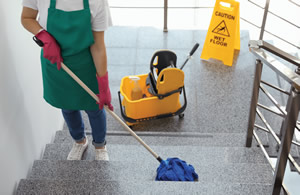Getting Clean
- By Michael Fickes
- 10/01/18

PHOTO © NEW AFRICA
How clean is clean on a college campus? Can cleanliness be measured and then improved? In fact, cleanliness is measured regularly on the best-kept college campuses. APPA, the Association of Physical Plant Administrators, provides a measuring system with five levels of cleanliness.
APPA’s Level 1 is the highest level and its cleanliness standard is spotless. Level 5 is the lowest level and refers to facilities that are unkempt and neglected. (Incidentally, APPA is also referred to as the Association of Higher Education Facilities Officers.)
“Many college and university campuses that we work with hover between Levels 2 and 3 of cleanliness,” says David Kornegay, community director with Cary, NC-based Dude Solutions, a company that provides software applications that help track and manage facility maintenance across institutional campuses such as colleges and universities.
“Levels 2 and 3 indicate that a facility is tidy,” continues Kornegay. “But there may not be enough personnel to provide the frequency of cleaning to reach Level 1.
“At Levels 2 and 3, there is no trash on the floor. There may be dull spots on the flooring, but nothing is dingy or burned out. It is tidy but not perfectly clean.” (See the accompanying sidebar for summaries of all five levels.)
Are college and university maintenance staffs trained in cleanliness measurement? Some, but not all, according to Kornegay. “I would like to see more staff trained in this system,” he says.
Types of Materials to Be Cleaned
As buildings have become more complex, different kinds of flooring, wall, and window materials have come into use. In addition, new instructional tools have appeared with new kinds of surfaces that need cleaning. Think of computerized whiteboards, for instance, with computerized markers. How do you clean these surfaces without damaging them?
Custodians must study and apply the cleaning specifications for these devices as recommended by manufacturers.
“In addition, different types of buildings, today, employ different types of materials that may require different cleaning processes,” notes Kornegay. “Consider luxury vinyl tile or LVT. Proper cleaning of this material requires training.
So, training is vital for proper cleaning—and also for safety, given the hazards connected to some cleaning materials.
Custodial Staffing Levels
Institutions often follow APPA guidelines for maintenance staffing levels per square foot. “APPA staffing level recommendations consider square footage and the frequency of cleaning required for various kinds of space. Cleaning services go beyond cleaning floors and include services such as changing trash liners, dusting, replacing light bulbs, and so on,” Kornegay says.
According to APPA literature, a good number of college and university operations teams have applied these APPA levels.
For example, Oakland University in Rochester, MI, uses the APPA standards. To meet those standards, Oakland’s Campus Cleaning Department employs 39 professionally trained custodians, who service about one million square feet of classroom, research, and office space.
According to Jon Barth, manager of custodial and grounds at Oakland University, “Campus Cleaning regularly achieves APPA’s Level 2 rating of cleanliness. Our department’s goal, each day, is to strive for Level 1.”
There are other cleaning standards to consider. For instance, Oakland University recently adopted what it calls a “cleaning for health” program, which instituted green and sustainable cleaning products that comply with the U.S. Green Building Code. Staff underwent a full day of training in the code.
How important are these codes to judging cleanliness? Surveys show that people notice. In one APPA poll of 1,481 Brigham Young University students, 88 percent defined what they believed to be a distracting educational environment. Their definition resembled APPA’s Level 3, defined as Casual Inattention, as well as Level 4, defined as moderate dinginess. Eighty-four percent said they wanted their school’s learning environment to meet requirements that resembled APPA’s Level 1 or Level 2 standards.
The Importance of Training
It might be noted that additional studies suggest that APPA’s Level 1 and Level 2 cleanliness standards help to promote learning, while less clean environments can detract from learning.
Kornegay also recommends constant custodial training. “In between cleaning routines, there must also be time for training,” he says. “Additional training should include dealing with hazardous materials and, perhaps worse, blood-borne pathogens—in case of an accident in which an individual receives a serious cut.”
Training should also cover the handling of cleaning chemicals, continues Kornegay. What are the appropriate cleaning chemical mixing ratios? Why is it important to adhere to these ratios? Custodians must know how much of each chemical to apply for the sake of adequate cleaning as well as safe use.
Safe handling techniques are important, too. What, for example, is the best way to transfer chemicals into spray bottles that are then properly labeled?
“Custodians also need training to understand the safe operation of power equipment,” Kornegay says. “For instance, there are different types of floor buffers. Some you push; some you ride.
“Custodians may have to use a lift to clean high areas and change lamps in fixtures set in high ceilings. To carry out these tasks, they will need to understand safety equipment, such as harnesses.
In the end, cleaning and custodial work are specialized jobs. “University managers should never short-change the custodial staff,” Kornegay says. “They are safeguarding the facilities for students, faculty, and staff.”
It is a job that has become much more than mopping. Today, it requires a specialized, technical expertise to ensure both cleanliness and safety.